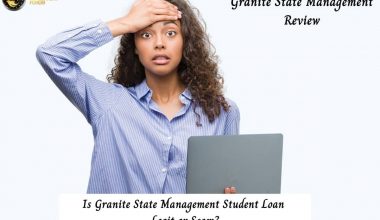Student loan forgiveness can relieve borrowers of their duties to repay their loan debt. You can have your student loan forgiven, canceled, or discharged. However, you must understand or learn the type of forgiveness and whether or not you are qualified due to your job or other circumstances.
Student loan forgiveness means you no longer need to repay part of your loan or all your load. Generally, it is called forgiven or cancellation when you no longer need to pay your load due to your job.
How to apply for student loan forgiveness depends on your eligibility. You fall on certain types of work, like Education, Military, or Public services. The good thing is forgiveness is available for all types of loans. But you must be qualified for your loan to be forgiven, canceled, or discharged.
In this article, we’ll share with you what is student loan forgiveness, what are the types of student loan forgiveness, how to apply for student loan forgiveness,
Table of contents
- What is student loan forgiveness?
- What are differences between forgiveness, cancellation and discharge.
- What are the types of forgiveness.
- 1. Public loan services forgivenes:
- 2. Teacher loan forgiveness
- 3. Closed school discharge.
- 4. Perkins loan cancellation and discharge
- 5. Total and permenant disability discharge
- 6. Discharge Due Death
- 7. Discharge in Bankrutcy
- 8. Borrowers Defense to Repayment.
- 9. Force certification discharge.
- 10. Unpaid Refund Discharge
- 11. Eligibility for Parent Borrowers
- How To Apply For Student Loan Forgiveness
- Conclusion
- References
- Recommendations
What is student loan forgiveness?
Student loan forgiveness relieves borrowers of their duty to repay a part or all of their federal student loan debt.
These borrowers obtained funds to pay for their post-secondary education. Forgiveness is available for a variety of loans, but those who are eligible for forgiveness tend to fall into certain types of work, such as public service, education, or the military.
In other words, if your loan is forgiven, canceled, or discharged, you are no longer required to repay some or all of your loan.
The recent high-profile failure of numerous for-profit institutions, as well as the pandemic-induced 2020 economic catastrophe, have heightened already-existing concerns about rising student debt.
In political circles, the idea of broader loan forgiveness for all borrowers, not just those who work in public service, enroll in a repayment plan, or have been scammed by their college, has become a popular topic.
What are differences between forgiveness, cancellation and discharge.
The words forgiveness, cancellation, or discharge are similar in meaning but are used in different ways.
Therefore, When you are no longer required to make on your loan due to your job, it is generally known as forgiveness or cancellation.
If you’re no longer required to make payment on your loan may be because of circumstances, such as total and permanent disability, or closure of a school where the loan was obtained, it can be called generally Discharge.
You can read this: Student Loan Forgiveness Scams In 2023
What are the types of forgiveness.
1. Public loan services forgivenes:
If you work for the government or a non-profit, you may be eligible for loan forgiveness through the Public Service Loan Forgiveness (PSLF) Program.
After you have made 120 qualifying monthly payments under a qualifying repayment plan while working full-time for an eligible company, PSLF forgives the remaining debt on your Direct Loans.
2. Teacher loan forgiveness
If you teach full-time for five consecutive academic years in a low-income elementary, secondary, or educational service agency, you may be eligible for loan forgiveness of up to $17,500 on your Direct Loan or FFEL Program loans.
3. Closed school discharge.
You may be eligible for a federal student loan discharge if your school closes while you’re enrolled or shortly after you withdraw.
4. Perkins loan cancellation and discharge
Based on your work or voluntary service, you may be able to have all or part of your Perkins loan canceled or discharged (under certain conditions). This includes the cancellation of Perkins Loans for Teachers.
5. Total and permenant disability discharge
You may be eligible for a discharge of your federal student debts if you are totally and permanently disabled or Teacher Education Assistance for College and Higher Education (TEACH) Grant service obligation.
6. Discharge Due Death
Due to the death of the borrower or the student on whose behalf a PLUS loan was taken out, federal student loans will be discharged.
7. Discharge in Bankrutcy
After filing for bankruptcy, you may be able to get your federal student loans dismissed. However, a bankruptcy discharge is not a one-way street
8. Borrowers Defense to Repayment.
If you took out the loans to attend a school and the school did or failed to do something relevant to your loan or the educational services that the loan was intended to pay for, you may be eligible for a discharge of your federal student loans based on borrower defense to repayment.
Depending on when you got your loan, the particular requirements for a borrower’s defense to repayment discharge may differ.
9. Force certification discharge.
You might be eligible for a discharge of your federal student loan if your school falsely certified your eligibility to receive a loan.
10. Unpaid Refund Discharge
If you withdrew from school and the school didn’t make a required return of loan funds to the loan servicer, you might be eligible for a discharge of the portion of your federal student loan (s) that the school failed to return.
11. Eligibility for Parent Borrowers
If loans are made to students, a Parent PLUS loan can be discharged if he/she dies, if you (maybe the student on whose behalf you obtained the loan) become permanently disabled, or if your loan is discharged in bankruptcy. If the child for whom you borrowed dies, your Parent PLUS loan may be forgiven.
There are some other ways parent PLUS loans can be discharged.
- If the student whom you borrowed for couldn’t complete his or her program due to school closure.
- If your eligibility to recieve the loan was falsely certified by the school.
- Also, if your eligibility to recieve the loan was fasely certified through identity theft.
- If the student withdrew from school, and the school was unable to pay a refund of loan money that was required to pay under application laws and regulations.
Also, check this: Easy Step by Step Guide on How to Get Student Loan Forgiveness in 2023: Programs and Tips
How To Apply For Student Loan Forgiveness
1. Get a full-time job with a qualifying employer.
PSLF rewards people who work in public service, so the determining factor is to know if you are eligible for PSLF is who your employer is.
Mainly, the following types of employers are eligible for PSLF:
- Federal, state, local, or tribal government organizations.
- 501(c)(3) nonprofit organizations.
- Non-501(c)(3) nonprofits that provide public services as their primary mission.
You have to be employed full-time at a qualifying organization to qualify for PSLF. Still, if you’re a volunteer in the Peace Corps or AmeriCorps, you may also be qualify.
2. Enroll in a qualified repayment plan
To qualify for PSLF, you need to be enrolled in one of four income-driven repayment plans. It has a payment term of 20-25 years.
You can be enrolled in the Standard Repayment Plan—the default plan you get enrolled in when you begin to pay off your federal loans.
The problem with that, however, is that the Standard Repayment Plan is a 10-years term. And under PSLF, you have to make 120 payments to have your loans are forgiven—which takes about ten years. That means your loan forgiveness lifts in as you make your last payment.
Keep in mind that the Standard Repayment Plan for Direct Consolidation Loans is different from the 10-year Standard Repayment Plan—and it doesn’t qualify for PSLF. If you have doubts about whether you’re on the right payment plan to qualify for PSLF, call your lender immediately.
3. Make 120 qualifying payments.
To qualify, your payment must be:
- Made under an income-driven repayment plan.
- For the total payment amount shown on your bill.
- No later than 15 days after the bill is due.
- While you’re working full-time for a qualifying employer.
You will not be able to make qualifying payments on PSLF while:
- Working for a non-qualifying employer
- Your loans are in deferment or forbearance
- You’re in school, or
- You’re in a repayment grace period
4. Complete the Employment Certification for PSLF Form
The form must be completed and sent at least once a year and even if you change employer.
The forms ensure that you’re working for a qualified employer as you make payments. If you do this, you may apply for forgiveness in ten years to find out that none of your payments qualified.
Your employer has to certify the document. Usually, the suitable person is somebody in your Human Resources department or your direct supervisor. Check with your employer to discover who’s authorized.
Once the government approves your form, it will inform you whether your employer and loans qualify or whether they want more documentation. They’ll also tell you how many qualifying payments you’ve made and how far you have to go.
5. Submit your PSLF application
If you make 120 qualifying payments, your loan will not be automatically forgiven. You have to submit another form after you’ve made your 120th qualifying payment
Conclusion
In other to get your student loan forgiveness you have to learn more about the types of forgiveness, whether you’re eligible due to the circumstance, total and permanent disability, closure of the school, or your job.
This situation can have your federal student loan forgiven, canceled, or charged.
We believe that this article you are reading right now will help you learn more about applying for student loan forgiveness.
References
- https://studentaid.gov/manage-loans/forgiveness-cancellation
- https://www.forbes.com/sites/markkantrowitz/2021/10/22/how-to-apply-for-student-loan-forgiveness
Recommendations
- Latest Trump Student Loan Forgiveness Proposals and Changes
- Student Loan Forgiveness Scams In 2023
- Easy Step by Step Guide on How to Get Student Loan Forgiveness in 2023: Programs and Tips
- How can Obama Loan Forgiveness & Discharge help me as a student in 2023?
- Best student loan forgiveness for lawyers in 2023 | Full Guide





